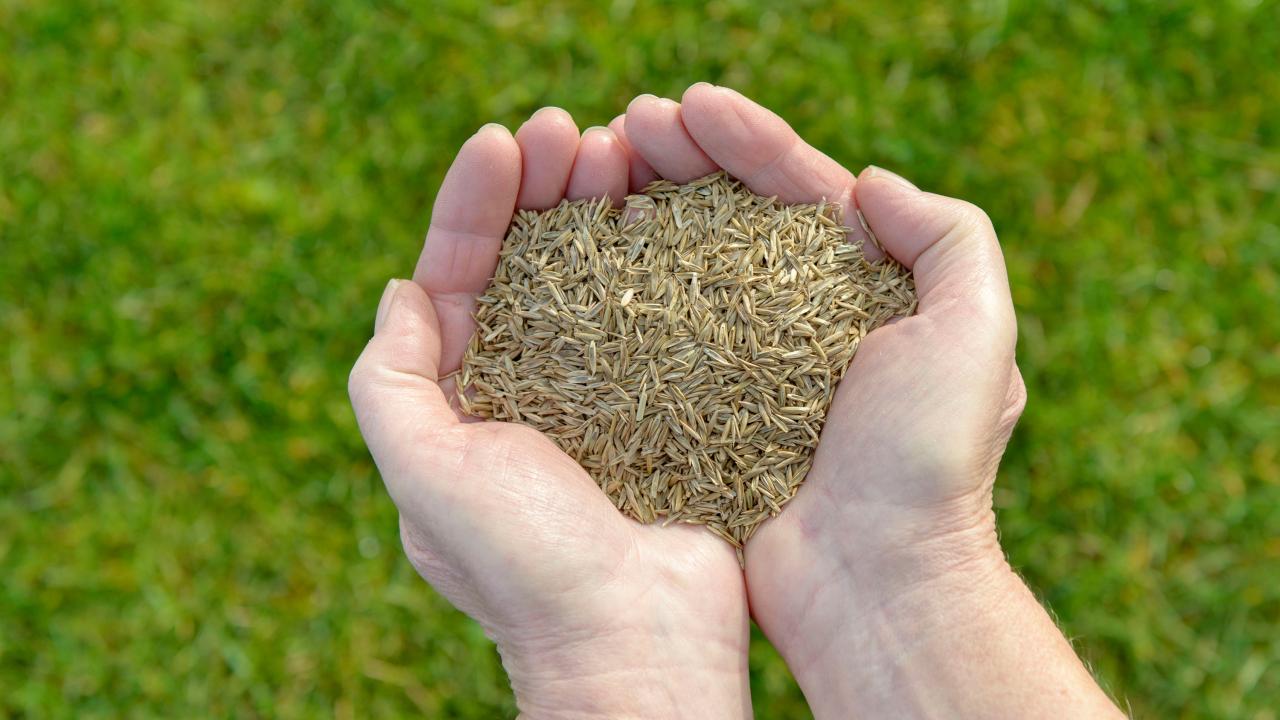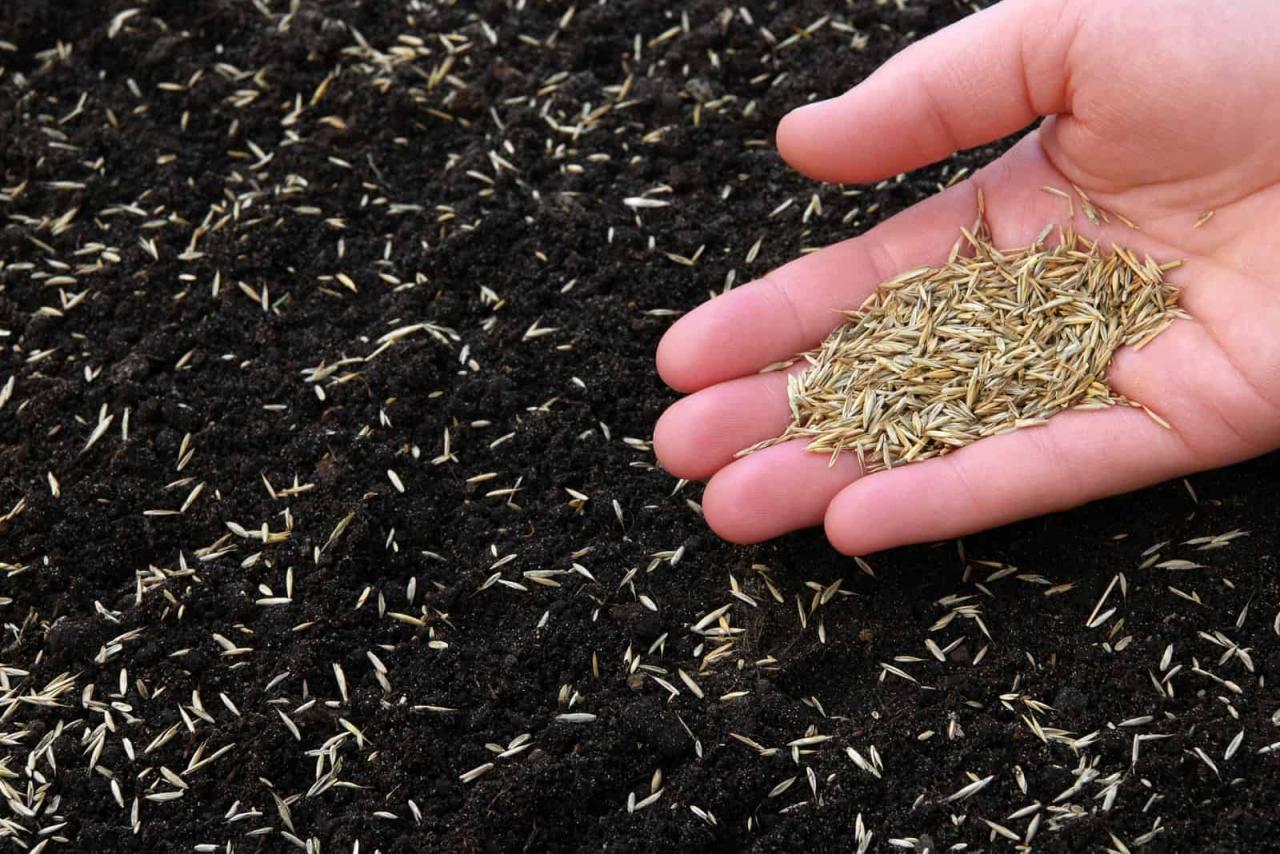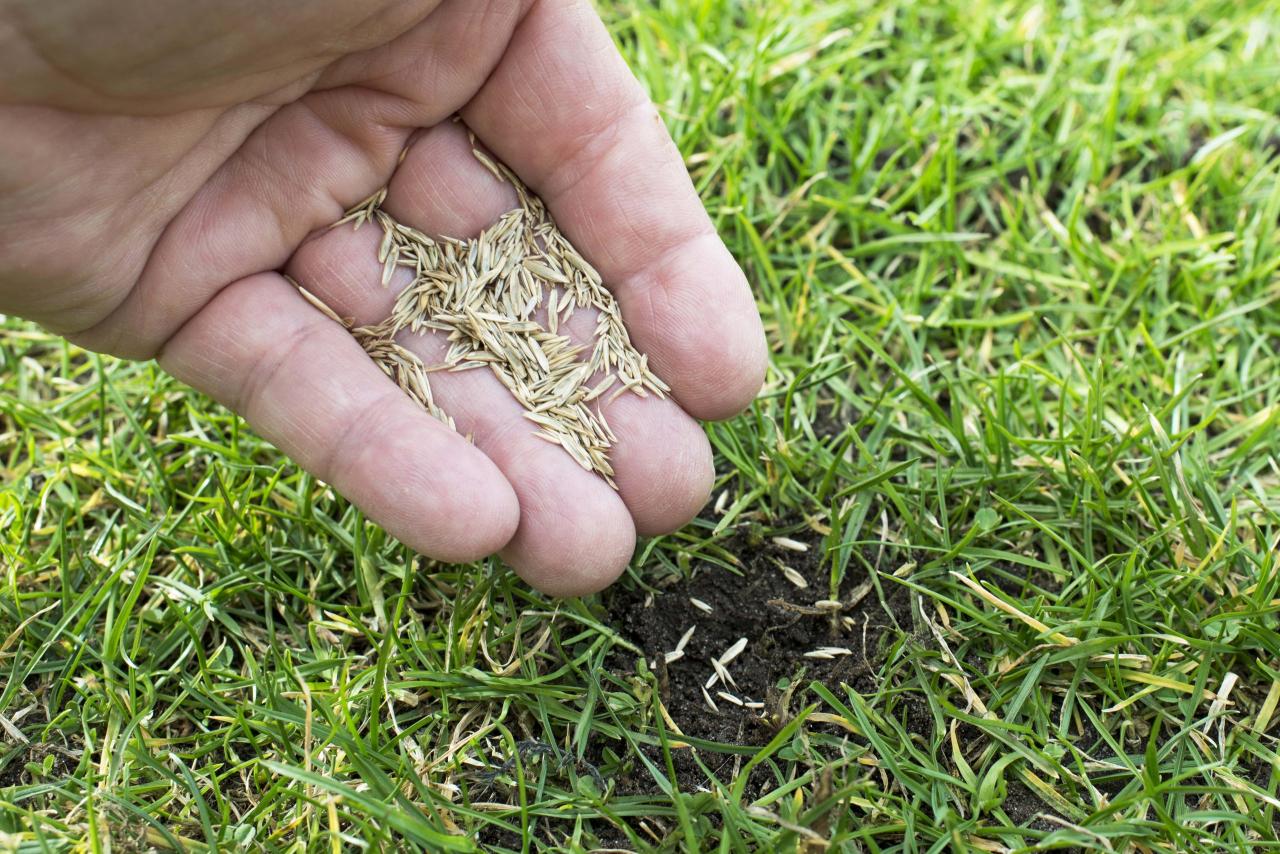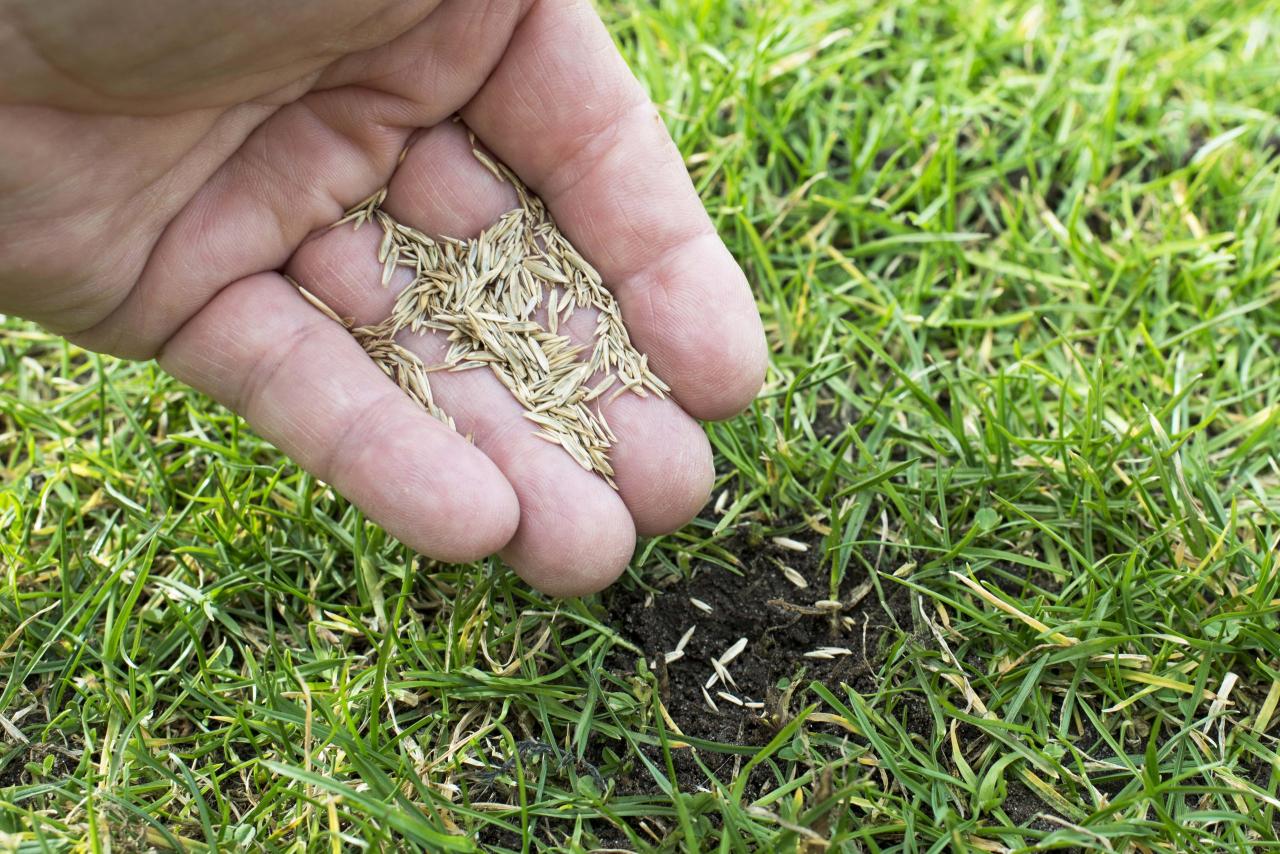Discover the Perfect Timing for Grass Seed Sowing: Expert Advice for Lawn Care – A lush, vibrant lawn is the dream of every homeowner, but achieving that dream requires more than just throwing down some seed and hoping for the best.
The key to a successful lawn is understanding the importance of timing, and that’s where this guide comes in. We’ll explore the optimal times for sowing different grass types, delve into the crucial factors that influence germination, and equip you with the knowledge and techniques to create a thriving lawn.
From the warm embrace of spring to the cooler days of fall, each season offers unique opportunities and challenges for grass seed sowing. By understanding the nuances of each season and the specific needs of your region, you can maximize your chances of success.
This guide will walk you through the entire process, from soil preparation and seed selection to proper watering and weed control, ensuring you have the tools and knowledge to create a lawn that will be the envy of your neighborhood.
Understanding the Importance of Timing
Timing is everything when it comes to sowing grass seed. Just like planting any other seed, the success of your lawn depends on providing the right conditions for germination and growth. These conditions are largely determined by the time of year you choose to sow your seed.
Factors Affecting Grass Seed Germination and Growth
The success of your grass seed sowing is influenced by a combination of environmental factors, including temperature, soil moisture, and sunlight.
Temperature
Grass seeds need a specific temperature range to germinate. Most cool-season grasses, such as Kentucky bluegrass, fescue, and ryegrass, germinate best in temperatures between 60°F and 75°F (15°C and 24°C). Warm-season grasses, such as Bermuda grass, zoysia grass, and St.
Augustine grass, prefer warmer temperatures, typically between 70°F and 85°F (21°C and 29°C).
Soil Moisture
Grass seeds need consistent moisture to germinate and establish roots. The soil should be moist but not waterlogged. If the soil is too dry, the seeds will not germinate. If the soil is too wet, the seeds may rot.
Sunlight
Grass seeds need sunlight to germinate and grow. Most grasses need at least six hours of sunlight per day. However, some grasses, such as fescue, can tolerate some shade.
Ideal Sowing Times for Different Grass Types
The following table provides a general guideline for the ideal sowing times for different grass types in various regions:| Grass Type | Ideal Sowing Time ||—|—|| Cool-Season Grasses | || Kentucky Bluegrass | Fall (September
- October) or Early Spring (March
- April) |
| Fescue | Fall (September
- October) or Early Spring (March
- April) |
| Ryegrass | Fall (September
- October) or Early Spring (March
- April) |
| Warm-Season Grasses | || Bermuda Grass | Late Spring (May
June) or Early Summer (July) |
| Zoysia Grass | Late Spring (May
June) or Early Summer (July) |
| St. Augustine Grass | Late Spring (May
June) or Early Summer (July) |
Spring Sowing

Spring is an ideal time to sow grass seed, offering the best conditions for successful germination and establishment. The warmer temperatures and increased moisture promote healthy growth, giving your lawn a strong start.
Preparing the Soil for Spring Sowing
Before sowing, preparing the soil is crucial. A well-prepared seedbed provides the optimal environment for germination and root development.
- Test Soil pH:Grass thrives in slightly acidic soil with a pH between 6.0 and 7.0. Use a soil testing kit to determine your soil’s pH. If the pH is too high or too low, amend the soil accordingly. Lime can raise the pH, while sulfur can lower it.
- Amend the Soil:Incorporate organic matter, such as compost or manure, to improve soil structure, drainage, and nutrient content. This will enhance seed germination and root growth.
- Till the Soil:Loosen the soil to a depth of 4-6 inches using a garden tiller or hand tools. This creates a fine seedbed, allowing the seeds to make good contact with the soil.
- Rake Smooth:Remove any debris, rocks, or large clumps. Rake the soil smooth to ensure an even seed distribution.
Spring Sowing Guide
Following these steps ensures successful spring grass seed sowing:
- Choose the Right Seed:Select a grass seed mix appropriate for your climate and soil type. Consider factors like shade tolerance, foot traffic, and desired grass height.
- Spread the Seed:Broadcast the seed evenly over the prepared soil. Use a spreader to ensure consistent distribution. Follow the seed rate recommendations on the packaging for optimal coverage.
- Rake the Seed In:Lightly rake the seed into the soil to ensure good contact. This helps prevent birds from eating the seed and promotes germination.
- Water Thoroughly:Water the seedbed immediately after sowing. Keep the soil consistently moist until the grass seedlings emerge. Avoid letting the soil dry out, as this can hinder germination.
- Protect the Seedlings:Keep foot traffic off the newly sown area until the grass seedlings have established. This prevents damage to the delicate seedlings and allows them to develop strong roots.
Fall Sowing
Fall sowing offers a unique opportunity to establish a lush, healthy lawn, taking advantage of cooler temperatures and longer germination periods. This method allows grass seeds to sprout and develop a strong root system before winter sets in, leading to a thicker, more resilient lawn come spring.
Fall Sowing Practices, Discover the Perfect Timing for Grass Seed Sowing: Expert Advice for Lawn Care
Fall sowing requires careful preparation and execution to ensure successful germination and establishment.
Soil Preparation
Proper soil preparation is crucial for optimal seed-to-soil contact and germination.
- Test Soil pH:Ideal pH for most grasses is between 6.0 and 7.0. Adjust accordingly using lime or sulfur.
- Aerate:This process removes compacted soil, allowing air and water to reach the roots.
- Rake and Remove Debris:Clear away leaves, twigs, and other debris to create a clean surface for sowing.
- Fertilize:Apply a balanced fertilizer with a higher phosphorus content to promote root growth.
Seed Selection
Choosing the right grass type for your climate and soil conditions is vital for successful fall sowing.
Just like knowing the right time to sow grass seed is crucial for a thriving lawn, mastering the art of rose propagation can save you a fortune. Learn how to effortlessly grow new rose bushes from cuttings by following the expert advice in Never Buy Roses Again: How To Propagate Roses From Cuttings and Save Money! , and you’ll be surprised at how quickly your garden blooms with beautiful, fragrant roses.
This knowledge will help you become a more self-sufficient gardener, just as understanding the ideal timing for grass seed sowing will lead to a lush, green lawn.
- Cool-Season Grasses:These grasses thrive in cooler temperatures and are ideal for fall sowing. Examples include Kentucky bluegrass, perennial ryegrass, and fine fescue.
- Warm-Season Grasses:These grasses are best sown in spring or early summer. However, some warm-season grasses, like Bermuda grass, can be overseeded in fall for improved winter hardiness.
Overseeding
Overseeding involves spreading grass seed over an existing lawn to thicken it and fill in bare patches.
- Timing:Overseeding should be done in early fall, about 6-8 weeks before the first frost.
- Seed Rate:Use the recommended seed rate for the chosen grass type.
- Method:Use a spreader to evenly distribute the seeds across the lawn. Light raking after sowing helps incorporate the seeds into the soil.
Benefits of Fall Sowing Different Grass Types
| Grass Type | Benefits of Fall Sowing ||—|—|| Kentucky Bluegrass | Establishes a strong root system before winter, leading to a thick, lush lawn in spring. || Perennial Ryegrass | Germinates quickly, providing rapid coverage and filling in bare spots.
|| Fine Fescue | Tolerates shade and drought, making it suitable for challenging lawn areas. || Bermuda Grass | Improves winter hardiness and helps maintain a green lawn throughout the colder months. |
Just like knowing the ideal time to sow grass seed for a lush lawn, understanding the right moment to propagate ivy can be a game-changer for your landscaping. To ensure your ivy thrives, check out Learn the Best Kept Secrets to Ivy Propagation – You’ll Be Amazed! , where you’ll discover expert tips for successful propagation.
With the right timing and techniques, you can enjoy a beautiful, thriving ivy display, just as you can achieve a picture-perfect lawn by choosing the optimal season for grass seed sowing.
Factors to Consider for Your Region

While understanding the general principles of spring and fall sowing is crucial, the ideal timing for your region depends on specific local conditions. This section will delve into the unique challenges and opportunities presented by different climate zones, highlighting the importance of considering local weather patterns and soil conditions.
Ideal Sowing Times for Various Regions
The following table provides a general guide for ideal sowing times in different regions. However, it’s essential to consult with local gardening experts or your state’s agricultural extension service for the most accurate information based on your specific location and microclimate.
Region |
Spring Sowing |
Fall Sowing |
|---|---|---|
Northern US (Zones 3-5) |
Mid-April to Mid-May |
Late August to Mid-September |
Southern US (Zones 7-9) |
Late February to Mid-March |
Mid-September to Mid-October |
Pacific Northwest (Zones 7-9) |
Mid-March to Mid-April |
Late September to Mid-October |
Midwest (Zones 4-6) |
Mid-April to Mid-May |
Late August to Mid-September |
Northeast (Zones 4-6) |
Mid-April to Mid-May |
Late August to Mid-September |
Local Weather Patterns and Soil Conditions
Understanding local weather patterns and soil conditions is vital for successful grass seed sowing. Consider the following factors:
- Last Frost Date:Avoid sowing grass seed before the last frost date, as freezing temperatures can damage seedlings. Consult local weather forecasts or gardening resources for this information.
- Average Rainfall:Ensure adequate rainfall during the germination and establishment phase. If rainfall is insufficient, supplemental watering is crucial.
- Soil Temperature:Grass seed germinates best in warm soil. Check the soil temperature using a soil thermometer to determine if it’s suitable for sowing.
- Soil Drainage:Ensure the soil drains well to prevent waterlogging, which can suffocate roots. Improve drainage if necessary by amending the soil with compost or sand.
Essential Tools and Techniques
Successfully sowing grass seed involves using the right tools and implementing proper techniques to ensure a healthy and thriving lawn. The process requires a combination of preparation, careful seed distribution, and consistent care.
Essential Tools for Successful Grass Seed Sowing
A well-equipped toolbox is crucial for a successful grass seed sowing project. Here are some essential tools:
- Rake:A rake is essential for preparing the soil surface. It helps remove debris, loosen the top layer, and create a smooth surface for seed distribution.
- Spreaders:Spreaders are designed for even distribution of seeds. They come in various types, including rotary spreaders and drop spreaders. Choose a spreader suitable for the size of your lawn and the type of seed you are using.
- Watering Can:Consistent watering is crucial for seed germination and growth. A watering can is a convenient tool for providing a gentle and even watering routine, especially in the initial stages.
- Measuring Tape:A measuring tape is helpful for determining the area you are seeding and calculating the required amount of seed.
- Garden Gloves:Protect your hands from dirt and debris while preparing the soil and handling seeds.
Proper Techniques for Seed Spreading
Even distribution of seeds is crucial for a uniform and dense lawn.
- Pre-Sowing Preparation:Before spreading the seeds, ensure the soil is properly prepared. This includes removing existing vegetation, tilling or raking the soil to loosen it, and leveling the surface.
- Seed Distribution:Using a spreader, distribute the seeds evenly across the prepared area. Follow the spreader’s instructions for optimal seed distribution. Ensure the seeds are spread evenly and not clumped together.
- Seed Depth:The depth at which you sow the seeds depends on the type of grass seed. Most grasses require a depth of about 1/4 inch. Use a rake to lightly cover the seeds with soil after spreading.
- Seed Coverage:After spreading the seeds, lightly rake the area to cover them with a thin layer of soil. This helps protect the seeds from birds and provides better contact with the soil.
Consistent Watering and Weed Control
Consistent watering is essential for seed germination and the establishment of a healthy lawn.
- Watering Routine:Water the seeded area frequently, keeping the soil consistently moist but not waterlogged. This encourages seed germination and root development. Adjust watering frequency based on weather conditions and soil type.
- Weed Control:Weeds can compete with young grass seedlings for nutrients and water. Pre-emergent herbicides can be applied before seeding to prevent weed growth. Post-emergent herbicides can be used to control weeds that emerge after seeding, but exercise caution as these can damage young grass.
Maintaining a Healthy Lawn

After successfully sowing your grass seed, nurturing it to thrive is crucial. Proper care ensures a lush, healthy lawn, enhancing its beauty and resilience. This involves a combination of consistent practices, including regular mowing, fertilization, and watering, along with proactive measures to address common lawn problems.
Post-Sowing Care
The initial weeks after sowing are critical for establishing a strong root system. Consistent care during this period maximizes germination and growth, setting the stage for a thriving lawn.
- Regular Mowing:Once the grass reaches a height of 2-3 inches, begin mowing regularly, but only remove one-third of the grass blade at a time. This encourages deeper root growth and prevents stress on the young seedlings.
- Fertilization:Apply a starter fertilizer specifically designed for new lawns. This provides essential nutrients for healthy growth and helps the grass establish itself. Follow the manufacturer’s instructions for application rates and timing.
- Watering:Water deeply and infrequently. Aim for a thorough soaking that reaches the root zone, but avoid overwatering, which can lead to fungal diseases. Water early in the morning to minimize evaporation.
Identifying and Addressing Lawn Problems
Even with proper care, lawns can encounter problems. Recognizing and addressing these issues promptly prevents further damage and maintains a healthy lawn.
- Weeds:Identify weeds early and remove them manually or use selective herbicides to control their spread. Preventing weeds is easier than removing them. Pre-emergent herbicides applied before weed seeds germinate can significantly reduce weed growth.
- Diseases:Fungal diseases are common lawn problems, especially in humid climates. Identify the disease by its symptoms, such as brown patches, yellowing, or wilting. Apply a fungicide specifically formulated for the identified disease, following label instructions. Improving drainage and avoiding overwatering can help prevent fungal diseases.
- Pests:Insects, such as grubs and chinch bugs, can damage lawns. Identify the pests and use appropriate insecticides, following label instructions. Natural methods like introducing beneficial insects or using nematodes can also help control pest populations.
Comprehensive Lawn Care Schedule
Season |
Tasks |
|---|---|
Spring |
|
Summer |
|
Fall |
|
Winter |
|
End of Discussion
Armed with this knowledge, you can confidently tackle the task of grass seed sowing, knowing that you’ve chosen the ideal time for your region and grass type. Remember, a well-timed sowing is the foundation for a healthy, thriving lawn that will bring you joy for years to come.
So, roll up your sleeves, grab your tools, and get ready to create the lawn of your dreams! Happy sowing!
FAQ Section: Discover The Perfect Timing For Grass Seed Sowing: Expert Advice For Lawn Care
What is the best time to sow grass seed in my area?
The ideal time for grass seed sowing varies depending on your region’s climate. Consult local gardening resources or your local extension office for specific recommendations.
How often should I water my newly sown lawn?
Newly sown grass needs consistent moisture to germinate and establish. Water deeply and frequently, especially during the first few weeks. Aim for 1-2 inches of water per week, depending on your climate and soil type.
What are some common lawn problems and how can I address them?
Common lawn problems include weeds, diseases, and pests. Identify the problem, then use appropriate control methods, such as hand-pulling weeds, applying fungicides, or using pest control products.
Can I overseed my existing lawn?
Yes, overseeding is a great way to thicken up your existing lawn and fill in bare spots. It’s best to overseed in the fall or spring, when temperatures are cooler and there’s more moisture.
